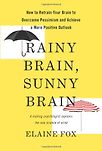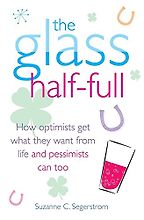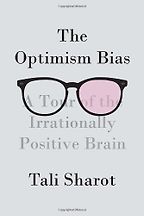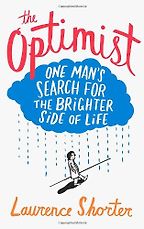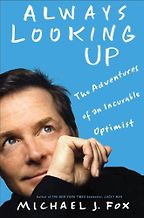What is optimism?
Optimism is really about having a very positive attitude towards the future. But there are a number of issues which are important to distinguish. One is that a lot of people think that optimism is about being overly positive about everything and believing that everything is going to turn out very well. That is a kind of blind optimism. But the kind of optimism that psychological research shows is actually of benefit is more of a realistic optimism. That optimism is having a generally positive feeling about how things are going to work out, but not necessarily believing that everything is going to work out perfectly for you. So an optimist is someone who is aware that even though things are likely to go wrong occasionally, they will be able to cope with them.
How do you think we can scientifically work out if someone is an optimist or not?
One way we can do it is by simply asking people – either talking to them or doing a structured interview. And there are a lot of standardised questionnaires we can use. One is the Life Orientation Test, which is seen as the standard measure of optimism.
How does that work?
It is 10 simple questions asking people how they feel about the future in terms of positive or negative. How they respond determines whether they can be viewed as an optimist or a pessimist. Another way of assessing this is by looking at what is actually happening in people’s brains. We can look at what happens when people are observing or thinking about very positive or negative things. For example, I might ask people to look at particular scenes or to watch short video clips of, say, something very positive and happy or something negative. And you can find different patterns of brain activity going on. The interesting thing is that those patterns of activity are also fairly enduring within the same individuals. So if I measure how your brain reacts to something, the chances are you will have a similar reaction a few months down the line. The same applies to the questionnaire. This is what psychologists call a trait measure – a predisposition to respond in a particular way.
How do you go about actually seeing what is going on in someone’s brain?
We can use something called EEG – which is electroencephalography. This basically just measures the electrical activity in the brain. There has been a finding that, generally speaking, when people are in a more positive state you find far more activity in the left-hand side of the brain. Conversely, when they are more anxious or fearful you find more activity in the right-hand side of the brain. We call this the cerebral asymmetry. The interesting thing is that you also find that pattern in monkeys and a lot of primates. So that is another way of picking up a positive or negative thinking style, but based very much on neural activity.
The Glass Half-Full by Suzanne Segerstrom takes those scientific studies further, and shows us that being an optimist can help you get ahead in life.
Yes. Segerstrom is one of the top psychologists working on optimism and pessimism. One of the things that she has found out through her research, and what she writes about in her book, is that optimism isn’t just about thinking. I make a similar point in my own book. A lot of self-help books make the assumption that optimism and pessimism is all about the way we think. But Segerstrom makes the strong point that optimism is also about what you do. For example, there is one simple experiment that she had done which we also replicated in my own laboratory, which is to give people a questionnaire so you can divide the groups into optimists and pessimists. Then we give the groups anagrams.
In her case she would give them a variety of anagrams, including one which is impossible to solve. What she found was that optimistic people were more likely to spend time trying to solve it and not to give up. She thinks that this persistence at a task is one of the key things that help optimists to become more successful in life, because they simply try harder and stick with things for longer. There is a can-do attitude which is absolutely the optimistic mind-set, and which translates into their actions. She is looking at this at a behavioural level rather than through brain states. She has also done some work looking at immune system functioning, measuring the immune system in optimists and pessimist with some surprising results.
Which were?
Basically, she took a group of law students, studied their immune systems over a period of time, and came across an interesting anomaly, which she believes that she can explain. It turns out that in the short term the optimistic law students often had a compromised immune system. But she thinks it’s because in their first year they were busy giving life their all and trying a lot harder than the pessimist students. They went out more, made more friends, studied harder and went to more lectures. Because of this they were more prone to a compromised immune system. But by the second year this worked in their favour because, unlike the more pessimistic law students, they had a wider support network to help them and boost their feeling of wellbeing.
Next up is The Optimism Bias by the neuroscientist Tali Sharot.
This is a fairly recent book which covers a lot more than just optimism. A large part of the book looks at irrationality. The idea is that we like to think that we are very rational and straightforward but actually we are not. She has picked up on this bias, which she calls the optimism bias. It has also been called the positivity illusion in the past – the idea that all of us tend to have a more optimistic take on life than is actually the case. For example, if I ask you whether you think you will earn more than the average person does in a lifetime you will probably say yes. Likewise, most people asked are convinced that they will be the ones having a happy marriage. If you ask people to predict all of these different things they tend to take a very optimistic view on them.
Why?
One of the arguments that Sharot makes is that this is very much of evolutionary benefit to us, because if we don’t have an optimistic take on life we won’t get out and do very much.
That ties in to your idea about the neuroscience of fear.
Yes. In my book, Rainy Brain, Sunny Brain, I talk about rainy brains and sunny brains. It is the case that our brain tunes in much more naturally to fearful stimuli, which I argue in evolutionary terms makes absolute sense. These were things that in the past we really needed to be looking out for to stay alive. There are two main kinds of information that our brain tunes into very naturally and this is genetically given. We tune into things that are dangerous to us, and things that are going to benefit us. That could be good food or sex. But fear trumps pleasure because it is far more important to notice something which is going to eat you.
Of course, with time we have had to learn to rationalise those fears – now, if we see a snake in a glass cage in a zoo, although initially we are fearful we can tell ourselves not to worry. We have learnt to balance the two. In my book I talk about the fear brain and the pleasure brain, and how they are the well springs of optimistic and pessimistic mind-sets. At the very root of a pessimistic mind-set is the fear brain, and at the very root of an optimistic mind-set is the pleasure brain.
Do you think some of us are preconditioned to be optimistic or pessimistic?
That is also something I have been researching. I have looked at particular genes to see whether they are related to optimism or pessimism. There is one gene, called the serotonin transporter gene, that has been linked to negative thinking in the past. People who have the short version of this gene show a more negative way of thinking than people with a longer version of the gene.
There was one long-term study conducted over a 23 year period, and they were specifically interested in looking at whether people with the shorter version of this gene were more prone to becoming depressed. We know that negative thinking is a risk factor for depression. At the end of their studies, they discovered that people with the short gene weren’t any more at risk than people with the long version of the gene. But that all changed when they looked at the kind of life experiences that people had. If four or more negative life events happened to them, like an accident, a bad illness or child abuse, the people with the short version of the gene were far less likely to cope with it well and then they did become more prone to depression. This is a very good early example of what we call gene by environment interaction. From that we can see that the interaction between the gene and the environment is very important.
Your next choice, The Optimist, is more of a personal book than a scientific one.
Laurence Shorter picked up on something that I think all of us are aware of – that there is a huge pessimism bias in the world around us, particularly in the media. He said that he was getting sick and tired of turning on the news or reading a newspaper, because all the time it just seemed to be bad news and negative stories. He thought, surely there is a brighter side of life? Surely there is a way of becoming more optimistic and finding optimism? So his book is about his quest to go out and find a brighter side of life.
How does he manage that?
He does several things. He visits scientists who have been working on optimism and he learns a lot from them. He talks to Buddhists who teach him about meditation and about being in the moment. It really is a fun read in terms of his efforts to try to find a more optimistic way of thinking and way of being. I am not sure whether he manages it in the end, but it is quite light-hearted and a fun read.
So it is a guide on how to be more optimistic despite all the gloom from the media?
Absolutely.
Next up, Barbara Ehrenreich
chooses to explore the downsides of optimism with her book Smile or Die.
This, again, is quite a personal book. She talks about her own experiences of when she developed breast cancer. When she discovered she had breast cancer she was extremely concerned and worried about it. Then she was completely horrified by the deluge of messages and emails she got from people telling her that it was a good thing it had happened to her, and that it was really going to help her find meaning in life. So she is writing a very critical overview of the positive thinking movement.
A relentless optimism despite everything?
Yes, the idea that if you think happy thoughts everything will be fine. She is very critical of a lot of the research that goes on in the positive thinking movement. This is something that goes on particularly in America. I don’t think it has taken off so much in Europe. Certainly in America, the movement says you should just be happy all the time and think happy thoughts all of the time. One of the things that I write about a lot in my book – and which is in Segerstrom’s book and in Tali Sharot’s book also – is that when you look at the type of optimism that psychological science shows is actually of benefit to us, it is not that kind of blind positive thinking. Optimism tied up with realism is what is of benefit. It is a very entertaining book which takes a sideswipe at a lot of the stuff you get in self-help books.
So an optimist in her situation would look at the best medical care and how you deal with it, but wouldn’t think “I am going to get better because I am thinking happy thoughts.”
Exactly. In fact, just thinking happy thoughts is quite dangerous a lot of the time. But I do think that at times she goes a little far. She also claims that a lot of the research doesn’t show any benefits for optimism, so you need to look at my other book choices as well to get a balance. Because there really is research out there which shows how optimism does benefit us.
Your final book is by the actor Michael J Fox, who developed Parkinson’s disease.
This again is a very interesting and personal book. As you mention, he developed Parkinson’s and was aware from a very early age that it was going to end his acting career. He writes in the book that there was no way he could continue his movie career with the kinds of problems that Parkinson’s brought. But one of the interesting things he makes clear is that in spite of all that he absolutely believed he would be able to deal with it, even though it meant that he might have to come up with a different career.
So he is one of life’s optimists.
Yes, and I think it illustrates very nicely that he is not the kind of optimist that Barbara Ehrenreich is talking about – he didn’t just think everything is going to be wonderful. He knew very well that things weren’t going to be wonderful, but he knew that he would be able to deal with it.
If you start out as one of life’s pessimists, do you think that you can train your brain to react to things differently so you have a more optimistic outlook?
I have been working for the last four or five years to research exactly that. In my book, I try to see whether we can shift from a more rainy brain state to a more sunny brain state.
From a practical point of view, what can we do to achieve that?
The good news is that there is scientific evidence that we can do that. The slightly less good news is that it isn’t easy. It isn’t just about having happy thoughts. But if we put the effort in, it is possible. There are a couple of techniques. One of them is mindfulness-based therapy, which is basically meditation. A lot of studies have been done looking at what changes in people’s brains, usually over an eight-week period. They will be trained in meditation techniques that they can do at home as well.
It sounds a bit like cognitive therapy.
It does tend to be linked to that, but it is more meditation. You learn to breathe deeply and to calm yourself, and there is no question that the research shows that those kinds of techniques do change your brain over an eight-week period, which is a pretty long period.
The other technique, which I have been looking at in particular detail, is called CBM – Cognitive Bias Modification. We know that pessimists have a negative bias in their attention, which means that they will home in at a very subconscious level to negative information. We have a technique, which we put on a computer, which is almost like retraining their brains to home in on the more positive information. The general technique is that we flash up two images. Let’s say you have a negative image and a positive image, the two images are played briefly on the computer screen, and then a target is displayed that they have to respond to. It could be something like a little blue square on the left or right side of the screen.
Over hundreds of trials we set it up so the target always appears behind the positive image, so that gradually their brains learn to instinctively be drawn towards the positive. When I did this test with Michael J Fox, as one of life’s optimists he was already drawn to the more positive images. But what we found is if we took a bunch of pessimistic students and put them through this training quite regularly, there is no question that when you measure their brain states before and after you do start to see changes. So you can change your brain state into a more optimistic mind frame – but it takes a lot of effort, either through computerised tasks or meditation.
March 8, 2012. Updated: June 16, 2019
Five Books aims to keep its book recommendations and interviews up to date. If you are the interviewee and would like to update your choice of books (or even just what you say about them) please email us at [email protected]
Five Books interviews are expensive to produce. If you've enjoyed this interview, please support us by donating a small amount.

